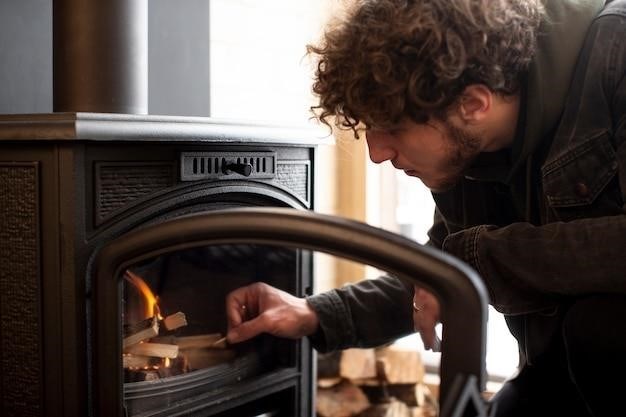
Fireplace Insert Size Guide⁚ A Comprehensive Overview
This guide helps you select the perfect fireplace insert․ We’ll cover determining the right size for your room, calculating BTU requirements, and understanding fireplace opening dimensions․ Accurate measurements are crucial for a proper fit and efficient heating․
Determining the Right Size for Your Room
Accurately determining the ideal fireplace insert size for your room is paramount for optimal heating and aesthetic appeal․ Begin by calculating your room’s cubic footage⁚ multiply length, width, and height․ Then, consider your room’s insulation⁚ a poorly insulated room (0․06 factor) will require a larger BTU output than a well-insulated one (0․035 factor)․ Multiply the cubic footage by the appropriate factor to estimate BTU needs․ Remember, this is just an estimate; consider factors such as ceiling height, window placement, and the presence of drafts․ A larger room or one with significant heat loss will necessitate a higher BTU output for adequate heating․ Consult a professional for personalized guidance if needed․ Don’t forget to factor in the desired ambiance; a smaller insert in a large room may feel underwhelming, while an oversized insert could overpower a smaller space․ The perfect size balances heating capacity with visual harmony․
Calculating BTU Requirements Based on Room Size
Precisely calculating BTU (British Thermal Unit) requirements is crucial for effective room heating․ A general rule of thumb suggests 20-30 BTUs per square foot, but this is a starting point․ Several factors influence BTU needs, including ceiling height, insulation quality, window efficiency, and the climate․ Poorly insulated rooms or those with extensive window areas demand higher BTU outputs․ For a 150 sq ft room, a 5,000 BTU insert might suffice; a 450 sq ft room may need 6,000-10,000 BTUs; and larger spaces (550-1200 sq ft) could require 12,000-23,000 BTUs․ These are estimates, and overestimating is better than underestimating․ An underpowered insert struggles to heat the space efficiently, leading to discomfort and potentially higher energy bills․ Consult manufacturer specifications for specific BTU outputs of different insert models․ Accurate BTU calculation ensures optimal heating comfort and energy efficiency․
Understanding Fireplace Opening Dimensions⁚ Height, Width, and Depth
Before purchasing a fireplace insert, meticulously measure your existing fireplace opening’s height, width, and depth․ These dimensions are critical for a proper fit․ Inaccuracies can lead to installation difficulties or an insert that doesn’t sit flush, compromising aesthetics and potentially safety․ Measure the opening’s height from the floor of the firebox to the top, checking both front and back for consistency․ Width should be measured at both the top and bottom of the opening to account for any tapering․ Depth measurements are equally important, taken from the front to the back at both the top and bottom of the opening․ Note any variations in depth, as some inserts might require a uniform depth․ Record these measurements precisely, noting units (inches or centimeters), to ensure accurate comparison with insert specifications․ Consider the hearth’s dimensions (depth and width) as well, ensuring sufficient space for the insert and preventing any obstructions․
Measuring Your Existing Fireplace for an Accurate Fit
Accurate measurements are paramount for a successful fireplace insert installation․ Take precise measurements of your fireplace opening, hearth, and any depth variations to ensure a perfect fit․
Measuring the Fireplace Opening⁚ Height, Width, and Depth
Precisely measuring your fireplace opening is the cornerstone of successful fireplace insert selection․ Begin by measuring the height from the floor of the firebox to the top, noting any variations; Next, measure the width at the widest point of the opening; Record both front and back measurements for the height to account for potential discrepancies․ Finally, determine the depth, measuring from the front to the back at both the top and bottom of the opening․ These measurements are critical for ensuring the insert fits correctly within the existing fireplace structure․ Don’t forget to account for any existing masonry or framing that might affect the insert’s fit․ Take your time, double-check your measurements, and record them accurately․ This meticulous approach ensures the perfect fit for your new fireplace insert, maximizing its efficiency and aesthetic appeal․ Remember, these measurements are vital for selecting the correct size insert and ensuring a safe and effective installation․ Paying close attention to detail at this stage prevents costly mistakes later on․ Consider taking photos to aid your selection process․
Measuring the Fireplace Hearth⁚ Depth and Width
Accurate hearth measurements are equally crucial for a seamless fireplace insert installation․ Start by measuring the depth of the hearth, the area extending from the fireplace opening outwards․ Measure from the edge of the fireplace opening to the furthest extent of the hearth․ Note any variations in depth; some hearths may be uneven․ Next, measure the width of the hearth․ This measurement should be taken at the widest point, ensuring you capture the entire width of the hearth․ Record these dimensions carefully, as they will influence the overall look and functionality of the installed insert․ A properly sized hearth provides ample space for the insert and ensures safe operation․ Insufficient hearth space can pose a fire hazard and may impact the insert’s performance․ Consider taking photographs of your hearth from multiple angles to assist in visualizing the dimensions․ Accurate measurements are vital for determining the appropriate size fireplace insert and ensuring a safe and aesthetically pleasing installation․ These measurements should be recorded alongside your fireplace opening dimensions to provide a complete picture for your selection process․
Considering Depth Variations Within the Fireplace
Many older fireplaces exhibit variations in depth, often shallower at the top and deeper towards the bottom․ This is a common characteristic of masonry fireplaces built over time․ Failing to account for these variations can lead to an ill-fitting insert and potential safety issues․ Therefore, measuring the depth at multiple points is crucial for accurate sizing․ Begin by measuring the depth at the top of the fireplace opening․ Next, measure the depth at the middle point of the opening․ Finally, measure the depth at the bottom of the fireplace opening․ Document all three measurements․ Significant depth variations might require a custom-fit insert or necessitate modifications to your existing fireplace․ Consult with a fireplace professional if you encounter substantial differences in depth․ They can assess the situation and recommend suitable solutions․ Accurate depth measurements are essential for a safe and efficient installation, preventing potential hazards and ensuring the optimal performance of your new fireplace insert․ Photographs from different angles can aid in visualizing the depth variations and assist in communicating the details to a professional if needed․

Choosing the Correct Fireplace Insert Size
Selecting the right size fireplace insert involves careful consideration of both dimensions and heat output (BTUs) to ensure a proper fit and adequate heating for your specific room size and needs․
Matching Insert Dimensions to Fireplace Opening
Precise measurements are paramount when matching a fireplace insert to your existing fireplace opening․ Carefully measure the height, width, and depth of the opening, noting any variations․ Consider the depth at both the top and bottom, as these can sometimes differ․ The insert’s dimensions should closely match those of the opening to ensure a snug fit․ Leaving gaps can compromise efficiency and safety․ Check manufacturer specifications for exact insert dimensions, including any allowances for framing or installation materials; A slightly smaller insert might be preferable to one that’s too large, as adjustments can sometimes be made, but a too-large insert cannot be easily accommodated․ Remember to account for any existing firebox features that might affect the installation process or the final dimensions of the insert․ Prioritize accuracy to avoid costly mistakes and ensure optimal performance․
Considering Heat Output (BTUs) for Adequate Room Heating
The British Thermal Unit (BTU) rating indicates a fireplace insert’s heat output․ This is a crucial factor in ensuring adequate heating for your room․ A general guideline suggests 20-30 BTUs per square foot of living space, though this can vary based on factors like insulation, ceiling height, and climate․ Rooms with poor insulation will require a higher BTU output compared to well-insulated spaces․ Consider the room’s size and its intended use when choosing a BTU rating․ A larger living area or a space with high ceilings will need a significantly higher BTU output than a smaller bedroom or office․ Overestimating BTU needs is less problematic than underestimating them; excessive heat can be mitigated, but insufficient heat cannot․ Always consult the manufacturer’s specifications for BTU output and ensure it aligns with your heating requirements․ Selecting the correct BTU rating ensures comfortable and efficient room heating․
Types of Fireplace Inserts and Their Size Ranges
Fireplace inserts come in various types, each with its own size range and characteristics․ Wood-burning inserts offer a traditional ambiance and range widely in size, from compact models suitable for smaller fireplaces to larger units capable of heating expansive spaces․ Gas fireplace inserts provide convenient, efficient heat and typically come in a broad array of sizes, accommodating different fireplace openings․ Electric fireplace inserts offer the most compact option, often designed for smaller spaces and featuring diverse size options․ The size of the insert should always match the dimensions of your existing fireplace opening․ Consider the fuel type’s efficiency and heat output when choosing a size․ Wood-burning units often have larger dimensions than gas or electric models, to accommodate the fuel source and larger combustion chamber․ Gas inserts are available in many sizes, and electric inserts range from small to medium depending on heating needs and the aesthetic you desire․ Carefully review manufacturers’ specifications and size charts to find the ideal fit for your fireplace and heating needs․
Installation and Safety Considerations
Proper installation is vital for safe and efficient operation․ Adhere to minimum clearance requirements for combustible materials․ Consult professional installers for complex installations or if you have any safety concerns․
Minimum Clearance Requirements for Combustible Materials
Maintaining safe distances between your fireplace insert and flammable materials is paramount․ Manufacturer instructions will specify exact clearances, but general guidelines exist․ These clearances typically involve maintaining a certain number of inches between the insert’s exterior and nearby walls, floors, and other combustible surfaces like wood framing or furniture․ Failure to adhere to these clearances significantly increases the risk of fire hazards․ Always check local building codes for additional regulations or requirements that may apply in your area, as these can vary depending on location and specific circumstances․ These codes often complement manufacturer recommendations, offering a layered approach to ensuring safe installation and operation․ Remember that proper ventilation is also crucial; sufficient airflow prevents overheating and reduces the risk of fire․ Prioritize safety and always consult a qualified professional if you have any doubts about meeting these requirements․
Proper Installation Techniques and Best Practices
Professional installation is strongly recommended for fireplace inserts․ While some DIY-inclined individuals attempt installation, the complexities of proper venting, connection to existing chimney systems, and adherence to safety regulations often necessitate expert handling․ Improper installation can lead to carbon monoxide leaks, inefficient heating, and fire hazards․ A professional installer possesses the knowledge and experience to ensure the insert is correctly positioned, securely fastened, and properly connected to the chimney system․ They’ll verify adequate clearances to combustible materials and ensure that all safety measures are in place․ Furthermore, professionals can identify potential issues with the existing fireplace or chimney, such as cracks or obstructions, and address them before installation․ This proactive approach minimizes future problems and maximizes the lifespan and efficiency of your new fireplace insert․ Always prioritize safety and seek professional expertise for a successful and safe installation․
